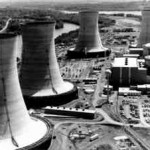
Digital News Report- Thirty years ago today a nuclear power plant in Pennsylvania partially melted down in what became known as the worst civilian nuclear accident in United States history. The incident, dubbed “Three Mile Island” due to it’s location three miles downriver of Middletown, Pennsylvania, marked a major turning point in the global development of nuclear power and federal regulations for power plants became more strict.
Today, however, nuclear power is being hailed as a safe and clean alternative to oil. The fear of nuclear power seems to have waned in recent years as the world faces global warming and the United States finds itself relying on foreign oil. Many proponents of nuclear power see the country as being on the verge of a “nuclear renaissance.”
There are currently 104 nuclear power plants in the United States which, when combined, produce about 20% of the countries energy. Since the incident at Three Miles Island, there has only been one new plant built. However, there are 17 applications for 26 new reactors pending before the Nuclear Regulatory Commission. These are the first new applications since the 1970s.
However, there are still many critics of nuclear power. “There are far better, cheaper ways to meet the electricity needs of today’s generation without burdening future generations for centuries with the deadly waste products,” said Ralph Nader, Consumer Advocate and former Presidential nominee. “Efficiency or conservation, with a national mission, can cut in half the waste of energy, using currently available technology and know-how, before the first privately capitalized nuclear plant opens.”
Christopher E. Paine, director of the National Resource Defense Council’s nuclear program, called “promoting nuclear power as a panacea for climate change is an irresponsible policy.” According to Paine, Uranium mining contaminates land and ground water and consumes vast quantities of fresh water for cooling.
The debate over nuclear power rages on with the hope of energy independents, new jobs, and a cleaner environment on one end and the fear of another incident and contaminated water on the other. As the 26 new reactors wait approval from the Nuclear Regulatory Commission, we can only speculate what lies ahead in nuclear energy.
